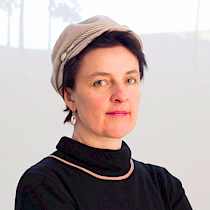Prof. Rasa Smite

Rasa Smite is internationally acknowledged artist and cultural innovator, working at the intersection of art, science and emerging media since the mid-1990s. She is founder of RIXC Center for New Media Culture in Riga (Latvia) and curator of the annual RIXC Art Science festivals. In her artistic practice, Rasa Smite works together with Raitis Smits as artist duo. Their pioneering internet radio “Xchange” project was awarded with PRIX Ars Electronica (1998). More recent artworks, such as “Talk to Me” – human-plant communication project, and “Biotricity” – sonic experiment series with “bacteria electricity”, have been shown in HeK (Basel), Ars Electronica, ZKM, MIT Center for Theoretical Physics (Boston), Venice Architecture Biennial, Futurium museum (Berlin). They have received The Excellence in Culture Award (2017) from Latvian Ministry of Culture; and their artwork “Swamp Radio. Fluctuations of Microworlds” (2018) was nominated for Purvitis Award in Visual Arts of Latvia.
Currently Rasa Smite is a guest professor at HfG-Karlsruhe, where she teaches seminars on TechnoEcologies and Virtualities and Realities, and her students actively take part in various international festivals and exhibition projects (RIXC Festival, Un/Green, Online/Offline, Beyond Festival).
http://smitesmits.com
Synopsis
Poetics and Aesthetics of Ecodata – Sensing and Visualizing the Forest Emissions.
Rasa Smite
We are used to thinking that planting trees is one of the key strategies in solving the climate problems. But we barely remember that the trees are living organisms, and a part of a larger and more complex ecosystem. The trees just don't produce oxygen, but breath as well, releasing a part of the carbon back into the atmosphere. They emit thousands of various volatile organic compounds (VOCs), which we can recall as the habitual smell of the forest.
Scientists for a while already have understood about the link between the fragrant trees and warming climate, but it is only recently when they've become aware of a massive scale of these processes. Within minutes to hours of trees releasing them, VOCs react with ozone and other chemicals in the atmosphere. They also react with air pollutants from anthropogenic sources, creating aerosols and contributing to cloud formation, thus, possibly, making global warming worse...
Predicting the effects of natural volatile emissions and its relation to the warming climate has been more complex than scientists thought, thus opening up a free vast space for artistic interpretations, speculations and future visions. For three years I have been working on my artistic research project “Atmospheric Forest” in collaboration with the Swiss scientists from The WSL Institute in the framework of SNSF-research project entitled “Ecodata-Ecomedia-Ecoaesthetics” in Basel.
To explore the interaction patterns between the emitting trees and changing weather conditions, I created an immersive environment in VR and visualized the data from one growing season of the pine-tree emissions in Pfynwald. It is an Alpine forest suffering from the drought, and which swiss scientists have turned into a 'living observatory'. To extend my artistic research on volatile emissions, I also performed a 'sensing experiment' by harvesting the resin and transforming it into two other substances: by distilling process I obtained a volatile liquid – a turpentine, an 'extract' of the forest scent; and by cooking I've got a hard consistency material – a colophon, a sculpture of a forest fossil.
By creating immersive experiences of the emitting virtual forest, as well as by performing sensing experiments with resin transformations, the “Atmospheric Forest” research project aims to challenge and deconstruct existing viewpoints and to reveal new perspectives. Moreover, Atmospheric Forest by sensing and visualizing the interaction between the 'terrestrial' and 'atmospheric' processes, creates green poetics and new aesthetics of 'ecological'.
All Speakers
- Refik Anadol
- Thorsten Bauer
- Prof. Stefanie Betz
- Prof. Ina Conradi Chavez
- Mark Chavez
- Florian Dohmann
- Dan Haab
- Dr. Lily Hibberd
- Prof. Jeroen van den Hoven
- Professor J. Stephen Lansing
- Mathew Lawrence
- Prof. Jason Edward Lewis
- Roman Lipski
- Dr. Sebastian Meier
- Prof. Galina Mihaleva
- Dave Murray-Rust
- Prof. Dr. Dr.-Ing. Jivka Ovtcharova
- Gülsel Özkan
- Dr. phil. Dipl.-Ing. Oliver Parodi
- Ludger Pfanz
- Thea Riofrancos
- Dr. Matthias Röder
- Seda Röder
- Prof. David Rolnick
- Prof. Rasa Smite
- Dr. Christoph Schneider
- Dr. Markus Schmidt
- Kathleen Schröter
- Prof. Vibeke Sorensen
- Holger Volland
- Prof. Victoria Vesna
- Prof. Charles Wang
- Yulu Wang
- Daniel Walther
- Prof. Dr. Steffen P. Walz
- Pawel Wargan
- Elizabeth Wathuti
- Prof. Dr. Marion Weissenberger-Eibl
- Wang Zhigang PH.D
Contact
Interesse? Fragen?
Schreiben Sie uns:
info@beyond-festival.com




